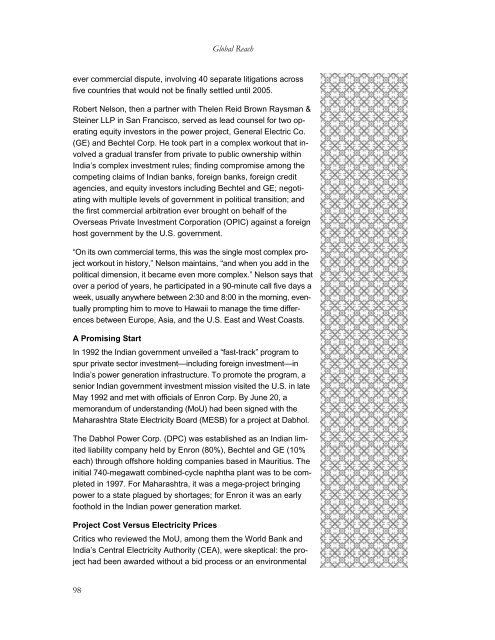PDF: 2962 pages, 5.2 MB - Bay Area Council Economic Institute
PDF: 2962 pages, 5.2 MB - Bay Area Council Economic Institute
PDF: 2962 pages, 5.2 MB - Bay Area Council Economic Institute
You also want an ePaper? Increase the reach of your titles
YUMPU automatically turns print PDFs into web optimized ePapers that Google loves.
Global Reach<br />
ever commercial dispute, involving 40 separate litigations across<br />
five countries that would not be finally settled until 2005.<br />
Robert Nelson, then a partner with Thelen Reid Brown Raysman &<br />
Steiner LLP in San Francisco, served as lead counsel for two operating<br />
equity investors in the power project, General Electric Co.<br />
(GE) and Bechtel Corp. He took part in a complex workout that involved<br />
a gradual transfer from private to public ownership within<br />
India’s complex investment rules; finding compromise among the<br />
competing claims of Indian banks, foreign banks, foreign credit<br />
agencies, and equity investors including Bechtel and GE; negotiating<br />
with multiple levels of government in political transition; and<br />
the first commercial arbitration ever brought on behalf of the<br />
Overseas Private Investment Corporation (OPIC) against a foreign<br />
host government by the U.S. government.<br />
“On its own commercial terms, this was the single most complex project<br />
workout in history,” Nelson maintains, “and when you add in the<br />
political dimension, it became even more complex.” Nelson says that<br />
over a period of years, he participated in a 90-minute call five days a<br />
week, usually anywhere between 2:30 and 8:00 in the morning, eventually<br />
prompting him to move to Hawaii to manage the time differences<br />
between Europe, Asia, and the U.S. East and West Coasts.<br />
A Promising Start<br />
In 1992 the Indian government unveiled a “fast-track” program to<br />
spur private sector investment—including foreign investment—in<br />
India’s power generation infrastructure. To promote the program, a<br />
senior Indian government investment mission visited the U.S. in late<br />
May 1992 and met with officials of Enron Corp. By June 20, a<br />
memorandum of understanding (MoU) had been signed with the<br />
Maharashtra State Electricity Board (MESB) for a project at Dabhol.<br />
The Dabhol Power Corp. (DPC) was established as an Indian limited<br />
liability company held by Enron (80%), Bechtel and GE (10%<br />
each) through offshore holding companies based in Mauritius. The<br />
initial 740-megawatt combined-cycle naphtha plant was to be completed<br />
in 1997. For Maharashtra, it was a mega-project bringing<br />
power to a state plagued by shortages; for Enron it was an early<br />
foothold in the Indian power generation market.<br />
Project Cost Versus Electricity Prices<br />
Critics who reviewed the MoU, among them the World Bank and<br />
India’s Central Electricity Authority (CEA), were skeptical: the project<br />
had been awarded without a bid process or an environmental<br />
98








